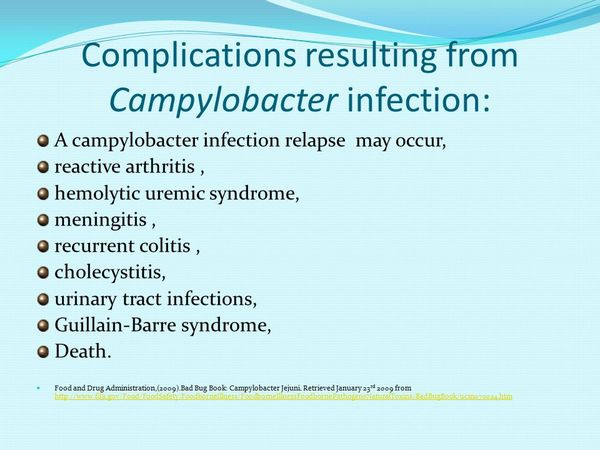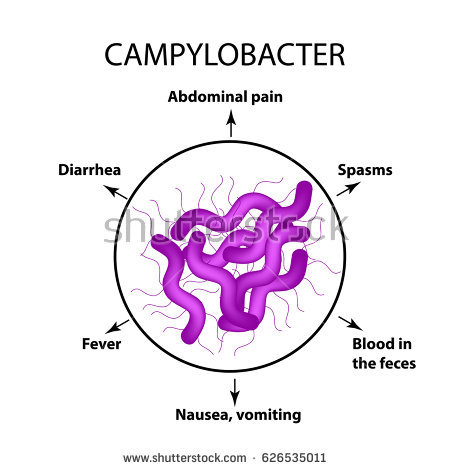Essentials of Diagnosis
- History of ingestion of appropriate foodstuffs.
- Causes enteritis, characterized by rapid onset of watery to bloody diarrhea with low-grade to moderate fever and moderate-to-severe abdominal cramping.
- Extraintestinal infections include sepsis, thrombophlebitis, endocarditis, and infection of aortic aneurysm.
- Laboratory isolation of a gram-negative “seagull” shaped bacteria, which becomes coccoid as the culture ages.
- These bacteria grow optimally in a microaerophilic, 5-10% oxygen environment; the growth of some species is enhanced by culture at 42 °C.
General Considerations
Epidemiology
Campylobacter species are intestinal commensals in many animals, including cattle, pigs, sheep, chickens, and turkeys. Contamination of foodstuffs during meat and dairy processing is thought to significantly contribute to the spread of disease. Unpasteurized dairy products, undercooked meats, and contaminated water serve as the vehicles for Campylobacter and other bacterial pathogens. Human-to-human transmission by way of a fecal-oral route or through contaminated blood is also possible.

In developing countries where overcrowding and poor sanitation conditions exist, the carriage rate of Campylobacter jejuni from healthy individuals is much higher and human-to-human transmission may be greater. Campylobacter is one of the etiologic agents of the infantile and childhood diarrhea diseases in developing countries. Although carrier rates are elevated in adults, symptomatic disease is less common; this is presumably because of enhanced immunity. In tropical climates, the incidence is higher during the rainy season and may be related to the corresponding overcrowding and contamination of local water supplies.

In developed countries, the carriage rate is very low (< 1%). This may result from more effective treatment of human waste, requisite pasteurization of dairy products, and educational efforts regarding the thorough cooking of meat products. In developed countries, campylobacteriosis tends to occur sporadically and year round, with peak incidence in months of the spring or fall. In many instances, infections can be linked to the ingestion of undercooked meats, contaminated milk, or contaminated water supplies.
Microbiology
Campylobacter are weakly gram-negative, curved or “seagull” shaped bacteria, with single polar flagella. Although usually bacillary, many Campylobacter species become coccoid as the culture ages. Special culture conditions, including selective media, a microaerophilic environment (5-10% oxygen), and for some species, culture at 42 °C (vs 35-37 °C), are required for optimal recovery of Campylobacter species.
Several Campylobacter species cause human disease (Box 6). C jejuni and C fetus are the prototypic etiologic agents for enteric and extraintestinal disease, respectively. Table 1 shows the principal biochemical reactions used to separate these and other Campylobacter species.
Pathogenesis
Establishment of infection in the small bowel and colon requires that an adequate inoculum is ingested and sufficient organisms survive after passage through the stomach and that the organisms attach and possibly invade enterocytes. Studies with volunteers have shown that as few as 500-1000 organisms may cause disease. Approximately 9000 organisms reportedly provide the highest illness-to-infection ratio; however, strain variation occurs.
Like Salmonella, Campylobacter organisms are susceptible to hydrochloric acid. Entry with foods that buffer stomach acid is important for gastric passage of viable organisms. C jejuni thrives in the small intestine and colon and is able to replicate in human bile. Infection is initiated by adhesion and colonization. Bacterial proteins that are important for this phase of infection include the superficial bacterial antigen PEB1, and possibly the newly characterized periplasmic binding protein P29. Peritrichous, piluslike structures that are present only when the organism is grown in the presence of bile, may also aid in adhesion.
Motility and the adhesion properties of the flagellar protein flagellin are additional virulence factors important for bacterial infection. The pathologic changes in the bowel wall and the occasional detection of C jejuni bacteremia are highly suggestive of bacterial invasion. Mild infections may show only an increased cellularity of the lamina propria due to neutrophils, lymphocytes, plasma cells, and histiocytes. Severe cases may disclose exudative enteritis with ulceration and crypt abscesses.
Extracellular toxins that cause cytopathic changes have been demonstrated. Additionally, a choleralike exotoxin has been suggested as a mechanism of diarrhea. The importance of these toxins remains to be elucidated, since non-toxin-producing strains have also been shown to cause disease.
C fetus is the Campylobacter species most frequently isolated from blood and is an important agent of extraintestinal disease. Enhanced invasion in a mouse model has been associated with the presence of a surface S protein. The S protein serves as a capsule and imparts an antiphagocytic property to the bacterium. This antiphagocytic property is due in part to the inhibition of the opsonizing complement component C3b. The S protein is antigenically variable as a result of rearrangements between highly homologous protein-encoding genes.




